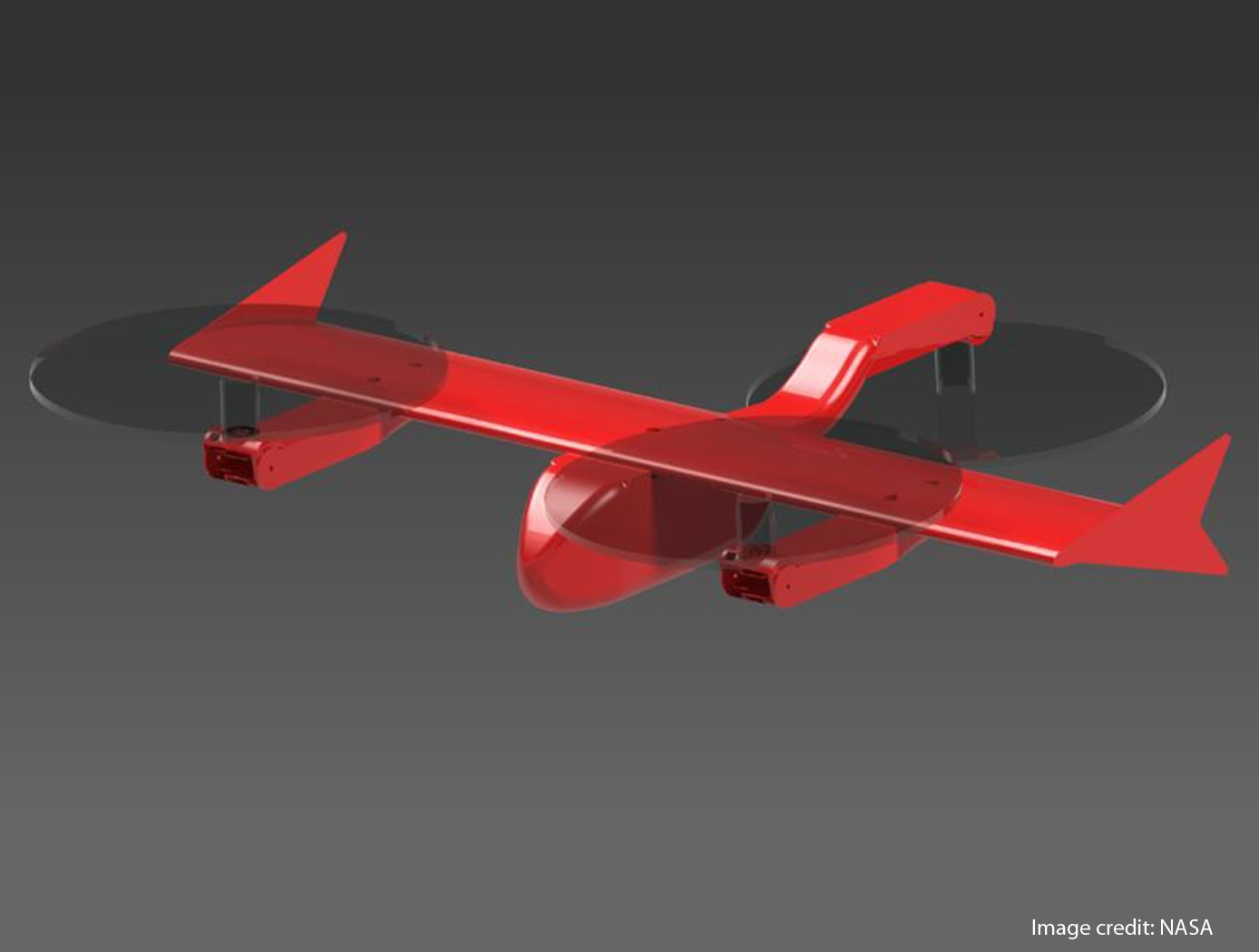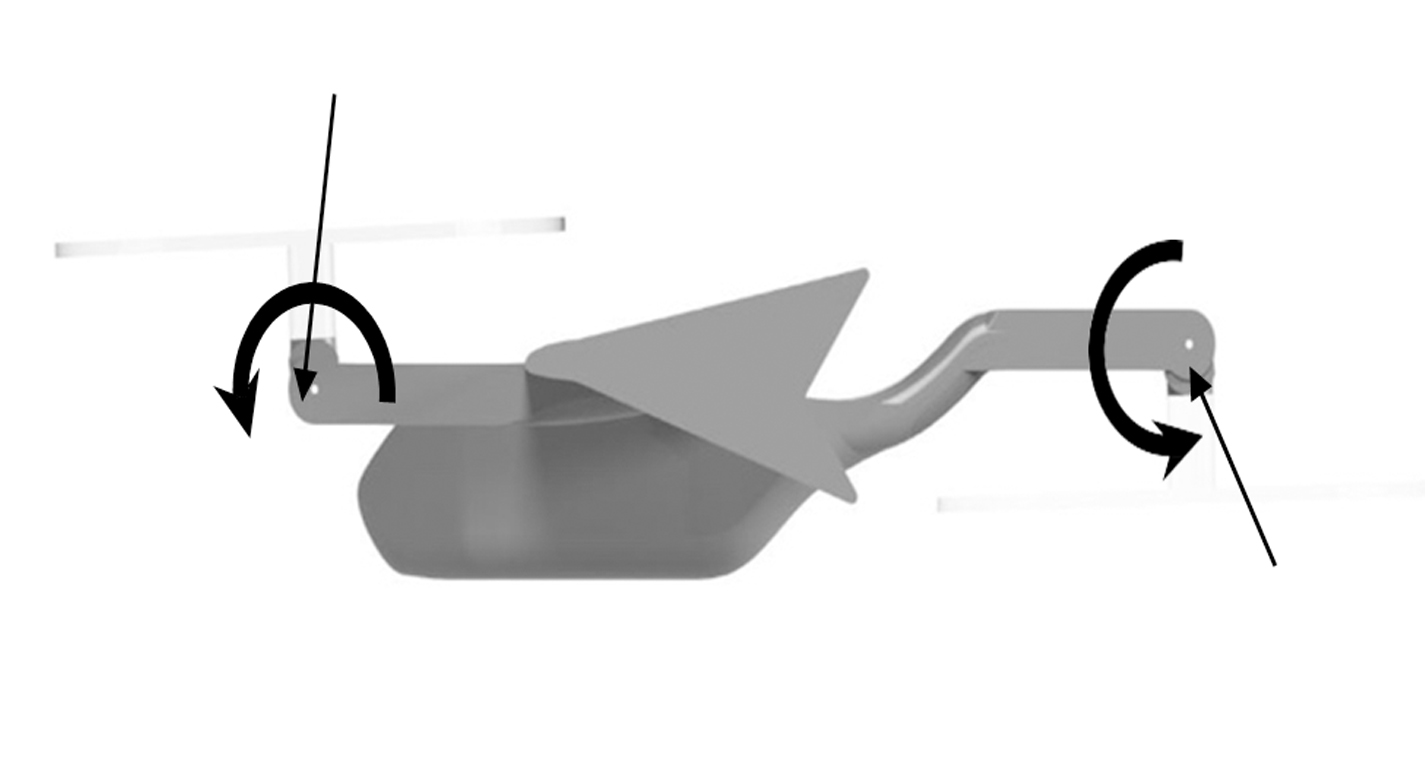Vertical Take Off and Landing (VTOL) Aircraft with Vectored Thrust for Control and Continuously Variable Pitch Attitude in Hover
aerospace
Vertical Take Off and Landing (VTOL) Aircraft with Vectored Thrust for Control and Continuously Variable Pitch Attitude in Hover (LAR-TOPS-283)
A new type of VTOL aircraft that can change its hovering orientation
Overview
Most fixed wing VTOL UAVs takeoff vertically, then transition to horizontal flight. This is new type of UAV which has unique capability. It can vary its hover position from "nose up" (tailsitter) to "nose forward" (non-tailsitter) incrementally and continuously, and even hold a position at any angle in between.
The Technology
The aircraft operates by vectoring the thrust of three independent rotors (propellers). In addition, the vehicle can operate with only thrust vectoring and motor speed control to maintain vehicle attitude in hover and forward (wing born) flight. No other means of vehicle attitude control is required (i.e. ailerons, elevators, rudder), however these additional control surfaces could be added if vehicle control is desired in gliding (non-thrust) conditions.


Benefits
- The vehicle airframe can be changed in hovering mode
- The ability of the vehicle to hover in two or more orientations
- The vehicle can maintain a constant altitude during flight the transitions
Applications
- Landing / takeoff from an oscillating or sloped site
- Pointing the fuselage at angles to augment the range of motion of an onboard camera
- VTOL takeoff/landing in windy conditions
Similar Results

Aerodynamically Actuated Thrust Vectoring Device
The thrust actuating device includes several innovations in the aerodynamically stable tilt actuation of propellers, propeller pylons, jets, wings, and fuselages, collectively called propulsors. The propulsors rotate between hover and forward flight mode for a tilt-wing or tilt-rotor aircraft. A vehicle designed using this technology can transition from a hovering flight condition to a wing born flight condition with no mechanical actuation and can do so without complex control systems. This results in a reduction in system weight and complexity and produces a robust and naturally stable hovering aircraft with efficient forward flight modes.

Small Compound-Wing VTOL UAS
This UAS technology defines a part-time VTOL system that transitions to efficient fixed-wing operation to obtain desired endurance and range. A novel three-segment wing design includes: a fixed Inner segment mounted to the fuselage, a controlled, articulating intermediate segment to which lift engines are attached, and a free-to-rotate outer segment to alleviate gust impacts on the airframe in both modes. The aft propulsor is articulated and configured such that the thrust being generated is always in a proverse direction. Also, the controlled-articulation wing segments are operated in both tandem and differential modes to allow for direct control while in the various modes of operation. Also incorporated is a novel control architecture that encompasses both the different system operating modes as well as the considerable number of individual control options and combinations.

Variable Geometry Aircraft Wing Supported By Struts and/or Trusses
This innovation utilizes a strut/truss-braced oblique variable-sweep wing mounted on a constant cross-section geometry fuselage. The combination of the strut/truss-bracing with the oblique wing greatly reduces the structural and weight penalties previously associated with unbraced oblique wing configurations while maintaining the oblique wings improved aerodynamic performance. Strut/truss bracing helps to further reduce the wing weight, and can be used to automatically align wing-mounted engines with the oncoming flow. The synergistic combination of these design elements provides the aircraft with a wide and efficient cruise speed range when the wing is at intermediate sweep positions, and superior low speed performance when the wing is unswept. The wing could remain aligned during taxiing, reducing the chance of collisions with other taxiing aircraft. This wide speed envelope provides future air traffic systems with additional flexibility when scheduling efficient arrivals and departures. The improved climb performance of the straight wing reduces the neighborhood noise footprint of the aircraft as it departs the airport. Efficient aircraft designs are increasingly desired in order to support the continued growth of the air transportation industry. Continued expansion of this vital mode of transportation is threatened by ever-increasing challenges in emissions, noise, and fuel efficiency.

VTOL UAV With the Cruise Efficiency of a Conventional Fixed Wing UAV
The core technology that enables the Greased Lightning UAV is the aerodynamic efficiency it achieves in its cruise configuration. Electric motors at each propeller negate the need for drive shafts and gearing which enables this Distributed Electric Propulsion (DEP) aircraft configuration. The design is intended to utilize a hybrid electric drive system that includes small diesel engines which drive alternators to power the electric motors and to charge an on-board battery system. The batteries provide the power boost needed for VTOL and hovering. Numerous other novel design elements are incorporated, such as folding propellers to minimize drag when not in operation, such that the propulsive efficiency can be nearly ideal at both hover and wing borne flight conditions.

Aircraft Vertical Takeoff & Landing
This technology is a vertical takeoff and landing (VTOL) aircraft that is a modification of a conventional single-prop aircraft design. The addition of vertically oriented, stowable tail rotors and an articulating forward rotor, capable of pivoting from a horizontal to vertical orientation, enables VTOL capabilities. It combines the speed and fuel efficiency of fixed wing aircraft with the hoverability and flexibility of rotary aircraft. The VTOL is designed for easy stowing in a cargo van making it easy to transport. The design is expected to avoid the compromises in performance that are typically made in development of VTOL aircraft.



